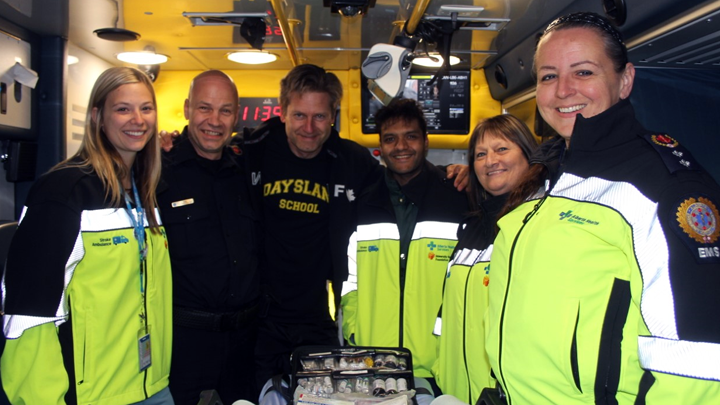
July 28, 2020

Stroke ambulance patient Steven Howrish, third from left, thanks staff members, from left, Kalene Hoefels, Keelly Brown, Dr. Ali Nomani, Marilyn Gibbons Doyle and Rae-Ann Hanson for their service. With its own CT scanner, this specialized ambulance is the only one in Canada that provides life-saving stroke interventions right in the field to boost recovery outcomes for patients.
Story by Vanessa Gomez | Photo courtesy of The Camrose Booster
Alberta is home to the only stroke ambulance in Canada — bringing life-saving stroke interventions to patients and providing them with the best opportunities for full recovery — thanks to the University of Alberta Hospital Foundation’s Brain Centre Campaign.
No one knows this better than Camrose resident and former teacher Steven Howrish. His life was changed in the winter of 2017 when he experienced a transient ischemic attack (TIA) — a mini-stroke caused by a small clot that briefly blocks an artery.
“I wasn’t sure what was happening at the time, but a colleague noticed I was acting differently and decided to take me to the Daysland Health Centre to see what was going on,” says Howrish.
It was determined Howrish required more comprehensive care, so the stroke ambulance was called. To save time, the Daysland ambulance transported him halfway and met with the stroke ambulance between the towns of Tofield and Ryley.
The customized ambulance is equipped with its own CT scanner, lab equipment and video and audio communication technology, which allows its specialized crew of five to consult with a physician at the University of Alberta Hospital.
Howrish remembers being put into the stroke ambulance and then seeing a doctor on the telehealth screen. His assessment determined he did not require the clot-busting drug tPA (tissue plasminogen activator), but the crew recognized the complexity of his situation. So Howrish was taken to the University of Alberta Hospital in Edmonton for further testing. There he was diagnosed with a rare condition, one which affects cognitive ability and causes stroke-like symptoms.
A stroke can occur due to a blockage or clot in a blood vessel in the brain (ischemic stroke), or when an artery in the brain breaks open (hemorrhagic stroke). It can lead to paralysis, loss of muscle control, pain, difficulty with language and speaking, and trouble with memory and thinking — all of which makes timely care of utmost importance in determining patient outcomes.
“Early intervention is key in minimizing potential damage caused by strokes,” says Dr. Thomas Jeerakathil, Associate Director of the Edmonton Stroke Program and a Professor of Neurology at the University of Alberta. “The time to treatment in the stroke ambulance is faster and can mean a difference in outcomes.”
Jeerakathil is also the co-physician lead, along with Dr. Ashfaq Shuaib, of the stroke ambulance project.
Right in the field, the stroke ambulance team confirms and differentiates between the different types of strokes and provides the best course of intervention on the spot.
As well, the crew typically arranges for about a third of patients to receive followup care closer to their homes and community, which eases the burden of long drives for loved ones and potential strains on urban hospitals. The ambulance is intended for rural settings, but many people in urban centres also benefit.
The stroke ambulance is part of a three-year pilot project — designed to evaluate its impact on communities and patients — which runs to March 2021.
While Howrish has no way of knowing if or when another stroke or TIA may occur, he’s determined to live his life to the fullest. He stays active with swimming and running and also volunteers his time teaching at the Camrose Women’s Shelter.
He also took the opportunity to travel through Australia and New Zealand with his partner last summer.
“I’m very grateful I can still continue to live my life,” he says. “When something like this happens, you need a quick response and I was just amazed with the team and the care I received.”